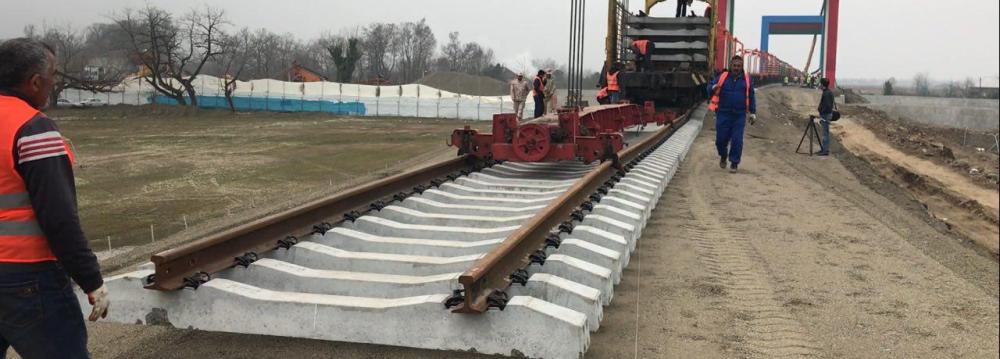Iran seems to have overcome challenges to procure rails and wagons to develop its ambitious plans in rail industry.
Minister of Roads and Urban Development Abbas Akhoundi said the government will operate 1,800 kilometers of railroads by the end of the current Iranian year (March 20, 2018), of which more than 900 km pertain to double-tracking.
Last week, a 267-km line between Tehran and Hamedan’s provincial capital came on stream.
Four other provincial capitals plan to join Iran’s rail network by the yearend, including Qazvin-Rasht, the so-called Gharb (West) project connecting the city of Arak in the central Markazi Province to Khosravi Border Crossing in the western Kermanshah Province bordering Iraq, Mahabad-Urmia and Mianeh-Bostanabad railroad projects.
The progress of most of these projects has been stymied by shortage of finance and equipment.
The Qazvin-Rasht railroad project, for example, has nearly come to a halt for a long time despite 91.5% progress.
According to Akhoundi, the 25-trillion-rial (over $650 million) project will be completed and launched by the end of summer.
The Gharb rail project includes two routes. The first section of the route, from Arak to Kermanshah, has made 95% progress.
Officials anticipate the inauguration, as soon as rail tracks and other components are put in place.
Indian Rail Supply
One major impediment to railroad expansion in Iran has traditionally pertained to rail procurement.
According to deputy minister of roads and urban development, Kheirollah Khademi, many track-laying projects have stopped due to shortage of rail, as tracks for more than 5 kilometers of railroads are laid across the country on a daily basis.
“There are not enough rails to meet the growing needs of Iran rail projects,” Islamic Republic of Iran Railways former chairman, Mohsen Pourseyyed-Aqaei, said last year.
According to Akhoundi, Iran needs 1.8 million tons of rails for its new railroad projects. IRIR has also said Iran is in need of an average of 300,000-400,000 tons of rails annually to meet the needs of this key transport sector.
This immediate need for rail is now being largely met by imports from India.
“Last year, India financed the supply of 2,000 kilometers of rail tracks,” Khademi said. “These shipped rail tracks helped speed up our projects.”
In August 2016, Indian steel and energy company Jindal Steel and Power Limited shipped the first consignment of 1,700 tons of head hardened rails, a specialty finished steel product, to Iran out of a total order for 150,000 tons.
The unique product, which has applications in tracks for metro rails and high-speed bullet trains, is manufactured by the company at its Raigarh steel mill.
“JSPL is producing the world’s longest rail at its Raigarh factory. We have bagged an order from Iran to supply 1.5 million tons of head hardened rails over a period of one and a half years,” a senior company executive was quoted as saying.
Russian Wagon Supply
The need for wagons is now largely being met by imports from Russia.
“We have signed contracts to purchase 7,000 wagons,” Akhoundi said on Monday.
Russia’s United Wagon Company has reportedly signed a deal to supply 6,000 freight wagons to Iran within three years, of which 4,900 cars will be produced inside the Islamic Republic.
UWC signed a preliminary agreement in Tehran on March 5 to supply 1,100 CBU (completely built unit) wagons to Iran in two years, 900 of which are to be imported in the first year of signing the final contract.
As for the remaining 4,900 cars, they will be produced jointly with three Iranian companies: Arak-based Wagon Pars will manufacture 2,200 wagons, Arak Steel 1,250 and the rest will be produced by Wagon Kowsar.
The Russian company has agreed to finance the contract. However, no financial detail is yet available.
The Industrial Development and Renovation Organization of Iran signed a joint venture contract with Russia’s CJSC Transmashholding late April to manufacture 500 wagons in Iran.
An IDRO press release quoted deputy for expansion of industrial investment, Fardad Daliri, as saying that the contract stipulates “attracting investment and using up-to-date technology in the domestic manufacture of freight and passenger cars".
“In the first phase, only passenger cars will be produced,” Daliri added, without elaborating on the details of the contract, including its estimated value.
Iran's 20-Year Vision Plan (2005-25) stipulates that the number of passengers using rail transport will increase from the current 25 million to 65 million per year.
Iran is planning to lay a total of 9,134 kilometers of railroads. The construction of more than 3,500 kilometers of railroads is currently underway.
The Iranian government has placed expansion of Iran's rail network on top of its agenda to facilitate transportation, preserve hydrocarbon fuels and reduce air pollution.
Iran’s sixth five-year development plan (2017-22) has tasked the government with increasing the share of rail in cargo and passenger transportation to a minimum of 30% and 20% respectively by the end of the plan.



